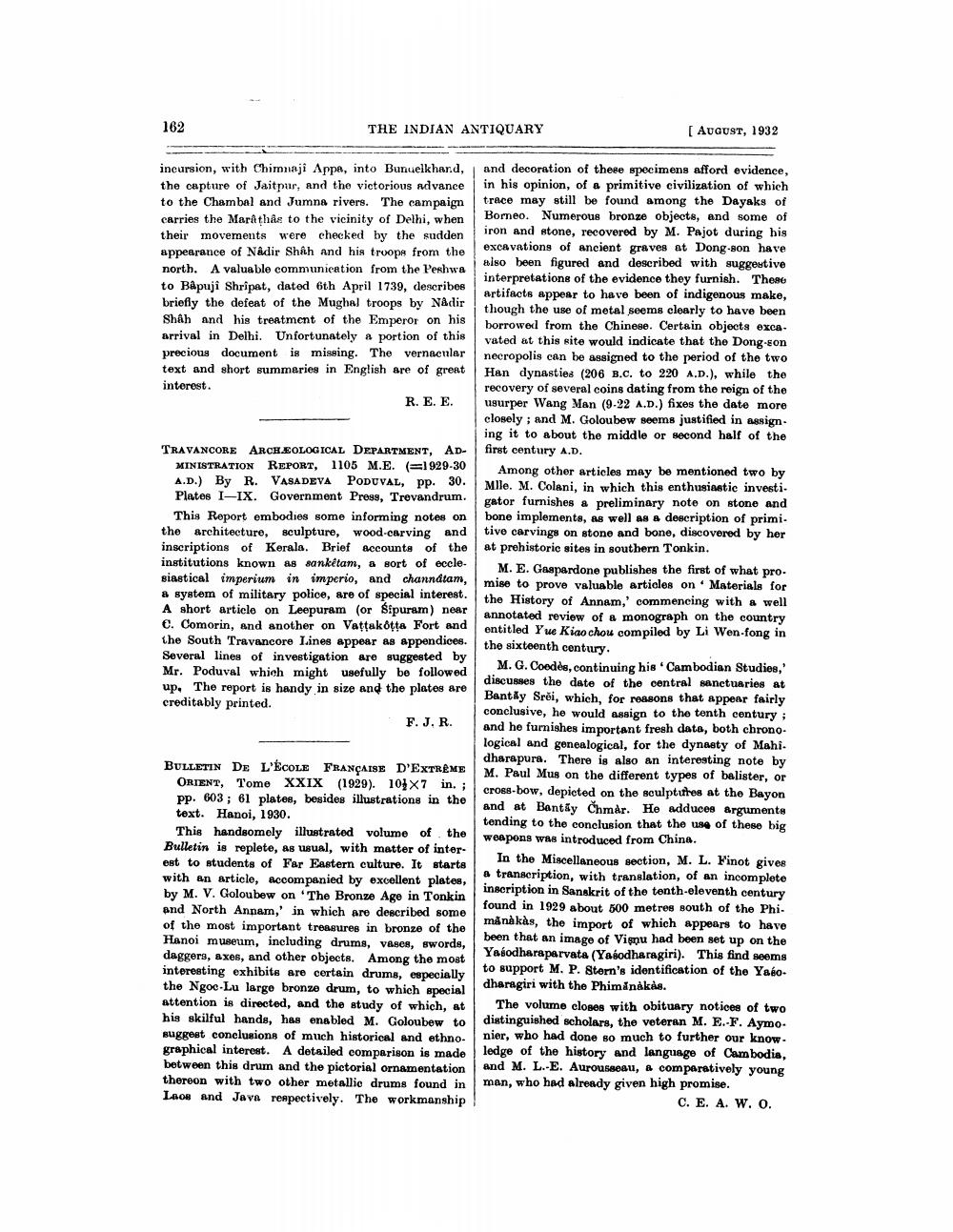________________
162
THE INDIAN ANTIQUARY
[ AUGUST, 1932
incursion, with Chimnaji Appa, into Bunuelkhand, and decoration of these specimens afford evidence, the capture of Jaitpur, and the victorious advance in his opinion, of a primitive civilization of which to the Chambal and Jumna rivers. The campaign trace may still be found among the Dayaks of carries the Marathås to the vicinity of Delhi, when
Borneo. Numerous bronze objects, and some of their movements were checked by the sudden
iron and stone, recovered by M. Pajot during his appearance of Nadir Shah and his troope from the
excavations of ancient graves at Dong-son have
also been figured and described with suggestive north. A valuable communication from the Peshwa
interpretations of the evidence they furnish. These to Bapuji Shripat, dated 6th April 1739, describes
artifacts appear to have been of indigenous make, briefly the defeat of the Mughal troops by Nadir
though the use of metal seems clearly to have been Shah and his treatment of the Emperor on his
borrowed from the Chinese. Certain objects exca. arrival in Delhi. Unfortunately a portion of this
vated at this site would indicate that the Dong-son precious document is missing. The vernacular
necropolis can be assigned to the period of the two text and short summaries in English are of great
Han dynasties (206 B.C. to 220 A.D.), while the interest
recovery of several coins dating from the reign of the R. E. E. usurper Wang Man (9.22 A.D.) fixes the date more
closely; and M. Goloubew seems justified in besign.
ing it to about the middle or second half of the TRAVANCORE ARCHAEOLOGICAL DEPARTMENT, AD- first century A.D. MINISTRATION REPORT, 1105 M.E. (=1929-30
Among other articles may be mentioned two by A.D.) By R. VASADEVA PODUVAL, pp. 30. Mlle. M. Colani, in which this enthusiastic investi. Plates I-IX. Government Press, Trevandrum.
gator furnishes a preliminary note on stone and This Report embodies some informing notes on bone implements, as well as a description of primi. the architecture, sculpture, wood carving and tive carvings on stone and bone, discovered by her inscriptions of Kerala. Brief accounts of the at prehistoric sites in southern Tonkin. institutions known as sankétam, a sort of eccle.
M. E. Gaspardone publishes the first of what pro. siastical imperium in imperio, and channdtam,
mise to prove valuable articles on Materials for a system of military police, are of special interest.
the History of Annam,' commencing with a well A short article on Leepuram (or sipuram) near
annotated review of a monograph on the country e. Comorin, and another on Vattakota Fort and
entitled Yue Kiao chou compiled by Li Wen-fong in the South Travancore Lines appear as appendices. the sixteenth century. Several lines of investigation are suggested by
M. G. Coedés, continuing his Cambodian Studies, Mr. Poduval which might usefully be followed
discusses the date of the central sanctuaries at up. The report is handy in size and the plates are
BantAy Sroi, which, for reasons that appear fairly creditably printed.
conclusive, he would assign to the tenth century; F.J.R.
and he furnishes important fresh dato, both chrono. logical and genealogical, for the dynasty of Mahi.
dharapura. There is also an interesting note by BULLETIN DE L'ÉCOLE FRANÇAISE D'EXTRÊME
M. Paul Mus on the different types of balister, or ORIENT, Tome XXIX (1929). 104X7 in.;
Cross-bow, depicted on the sculptures at the Bayon PP. 603; 61 plates, besides illustrations in the
and at Bantły Chmår. He adduces argumente text. Hanoi, 1930.
tending to the conclusion that the use of these big This handsomely illustrated volume of the
weapons was introduced from China. Bulletin is replete, As usual, with matter of interest to students of Far Eastern culture. It starts
In the Miscellaneous section, M. L. Finot gives with an article, accompanied by excellent plates,
a transcription, with translation, of an incomplete by M. V. Goloubew on 'The Bronze Age in Tonkin
inscription in Sanskrit of the tenth-eleventh century and North Annam,' in which are described some
found in 1929 about 500 metres south of the Phi. of the most important treasures in bronze of the
månakas, the import of which appears to have Hanoi museum, including drums, veses, swords,
been that an image of Vişnu had been set up on the daggers, axes, and other objects. Among the most
Yasodharaparvata (Yasodharagiri). This find seems interesting exhibits are certain drums, especially
to support M. P. Stern's identification of the Yaéothe Ngoc-Lu large bronze drum, to which special
dharagiri with the Phiminskas. attention is directed, and the study of which, at
The volume closes with obituary notices of two his skilful hands, has enabled M. Goloubew to distinguished scholars, the veteran M. E.-F. Aymo. Buggest conclusions of much historical and ethnonier, who had done so much to further our knowgraphical interest. A detailed comparison is made ledge of the history and language of Cambodia, between this drum and the pictorial ornamentation
and M. L.-E. Aurousseau, & comparatively young thereon with two other metallie drums found in
man, who had already given high promise. Laon and Java respectively. The workmanship
C. E. A. W. 0.




